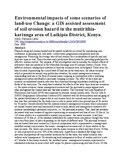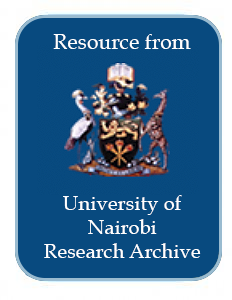Location
Our Vision is to be a world-class university committed to scholarly excellence.
Our Mission is to provide quality university education and training and to embody the aspirations of the Kenyan people and the global community through creation, preservation, integration, transmission and utilization of knowledge.
Core Values
In order to realize the above vision and mission, certain shared values shall be nurtured. There is great need for the University to be guided by the right values derived from the virtues and moral standards of the Kenyan and wider society.
Core Functions
Teaching and Learning: The university offers innovative , relevant and market driven academic programmes , both at undergraduate and postgraduate levels with inbuilt quality control systems the university also provides an environment and policy framework for undertaking high quality and relevant research
Members:
Resources
Displaying 226 - 230 of 298Environmental impacts of some scenarios of land-use Change: a gis assisted assessment of soil erosion hazard in The Mutirithia-Kariunga area of Laikipia District, Kenya.
Characterizing soil erosion hazard and its spatial variability is critical for maintaining
user confidence in planning soil- and water- conservation programmes and general
land-use management. Predicting the average rates of soil erosion for a combination
of specific soil and land-use types is vital. This is because such predictions form a
basis for providing guidelines for effective erosion control.
The purpose of this investigation was to examine the erosion effects of alternative
Legume cover crops for soil fertility improvement in the highlands of eastern Africa region. Report of an AHI workshop
This report reviews work on legume cover crops in eastern Africa and provides a summary of recommendations of the appropriate germplasm, management and posible niches for these plants in farming systems. It briefly identifies various reseasons for the lack of adoption of LCC in farming sysytems. The focus is primarily on herbaceous legume cover plants that attain maximum biomass in less than 12 months.
Land use and land cover changes in the greater Amboseli ecosystem, Kajiado District, Kenya between 1988 and 1998.
For millenia, Greater Amboseli ecosystem of Kenya has had a central role in subsistence
pastoralism and wildlife conservation by providing vast biological resources for pastoralists and
their livestock; and habitat for wildlife. Recently, with the creation of Amboseli National Park
and rapid changes in land tenure systems, the human use of the ecosystem has intensified. This
change has shaped a pastoral landscape composed of livestock grazing, wildlife conservation,
Land and water management in Kenya: towards sustainable land use.
Preliminary findings on the effects of land use in the Masinga Dam catchment, Kenya, on the storage capacity of the reservoir are presented. Remote sensing and GIS techniques, supplemented with ground reports, were used to determine areas most susceptible to erosion. A representative catchment was then chosen for rainy season monitoring of soil loss, river suspended sediments and discharge response to rainfall. In addition, Gerlach-type traps were used to evaluate erosion rates under different crop covers and slope gradients.
The socio-economic implications of land registration in Tongaren division, Bungoma district
This study examined the socio-economic consequences of land registration In
Tongaren Division, Bungoma District. It was designed to assess how land registration has
impacted on food security, income, gender parity in the ownership of land and, on
kinship ties and social relations. The study was hinged on the premise that land tenure
reform program in Tongaren division has not lived up to its promises. It was justified to
carry out this study on the grounds that land is the matrix of life of many people in this




